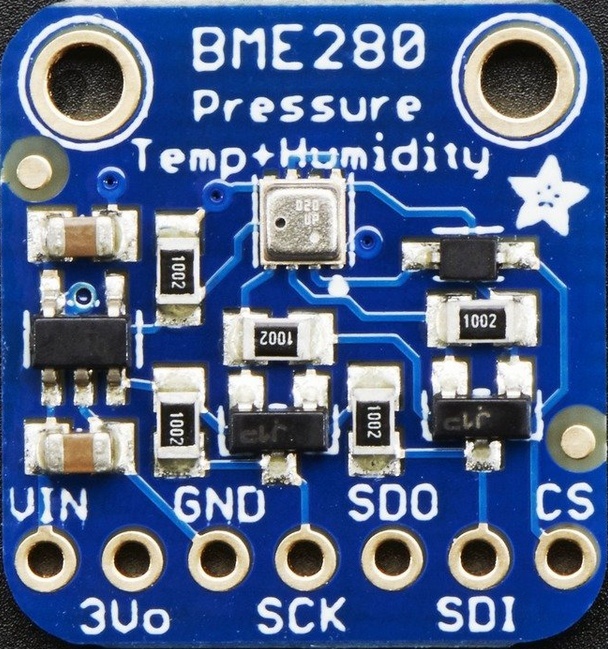Différences entre versions de « BME280-pinout »
(Page créée avec « {{BME280-NAV}} {{traduction}} {{BME280-TRAILER}} ») |
|||
| Ligne 2 : | Ligne 2 : | ||
{{traduction}} | {{traduction}} | ||
| + | |||
| + | == BME280 Breakout == | ||
| + | {{ADFImage|BME280-pinout-01.jpg|640px}} | ||
| + | |||
| + | == Alimentation == | ||
| + | * '''Vin''' - this is the power pin. Since the sensor chip uses 3 VDC, we have included a voltage regulator on board that will take 3-5VDC and safely convert it down. To power the board, give it the same power as the logic level of your microcontroller - e.g. for a 5V micro like Arduino, use 5V | ||
| + | * '''3Vo''' - this is the 3.3V output from the voltage regulator, you can grab up to 100mA from this if you like | ||
| + | * '''GND''' - common ground for power and logic | ||
| + | |||
| + | == Bus SPI == | ||
| + | All pins going into the breakout have level shifting circuitry to make them 3-5V logic level safe. Use whatever logic level is on '''Vin'''! | ||
| + | * '''SCK''' - Broche du signal d'horloge ('''S'''PI '''C'''loc'''k'''), c'est une broche d'entrée du BME280 | ||
| + | * '''SDO''' - Broche de Sortie de donnée ('''S'''erial '''D'''ata '''O'''ut / Master In Slave Out pin), for data sent from the BMP183 to your processor | ||
| + | * '''SDI''' - Broche d' Entrée de donnée ('''S'''erial '''D'''ata '''I'''n / Master Out Slave In pin), for data sent from your processor to the BME280 | ||
| + | * '''CS''' - this is the Chip Select pin, drop it low to start an SPI transaction. Its an input to the chip | ||
| + | |||
| + | If you want to connect multiple BME280's to one microcontroller, have them share the SDI, SDO and SCK pins. Then assign each one a unique CS pin. | ||
| + | |||
| + | == Bus I2C == | ||
| + | * '''SCK''' - this is ''also'' the I2C clock pin, connect to your microcontrollers I2C clock line. | ||
| + | * '''SDI''' - this is ''also'' the I2C data pin, connect to your microcontrollers I2C data line. | ||
| + | |||
| + | Leave the other pins disconnected | ||
{{BME280-TRAILER}} | {{BME280-TRAILER}} | ||
Version du 2 janvier 2017 à 20:35
|
|
En cours de traduction/élaboration. |
BME280 Breakout

Crédit: AdaFruit Industries www.adafruit.com
Alimentation
- Vin - this is the power pin. Since the sensor chip uses 3 VDC, we have included a voltage regulator on board that will take 3-5VDC and safely convert it down. To power the board, give it the same power as the logic level of your microcontroller - e.g. for a 5V micro like Arduino, use 5V
- 3Vo - this is the 3.3V output from the voltage regulator, you can grab up to 100mA from this if you like
- GND - common ground for power and logic
Bus SPI
All pins going into the breakout have level shifting circuitry to make them 3-5V logic level safe. Use whatever logic level is on Vin!
- SCK - Broche du signal d'horloge (SPI Clock), c'est une broche d'entrée du BME280
- SDO - Broche de Sortie de donnée (Serial Data Out / Master In Slave Out pin), for data sent from the BMP183 to your processor
- SDI - Broche d' Entrée de donnée (Serial Data In / Master Out Slave In pin), for data sent from your processor to the BME280
- CS - this is the Chip Select pin, drop it low to start an SPI transaction. Its an input to the chip
If you want to connect multiple BME280's to one microcontroller, have them share the SDI, SDO and SCK pins. Then assign each one a unique CS pin.
Bus I2C
- SCK - this is also the I2C clock pin, connect to your microcontrollers I2C clock line.
- SDI - this is also the I2C data pin, connect to your microcontrollers I2C data line.
Leave the other pins disconnected
Source: "Adafruit BME280 Humidity + Barometric Pressure + Temperature Sensor Breakout" réalisé par LadyAda Pour AdaFruit Insdustries.
Traduit avec l'autorisation d'AdaFruit Industries - Translated with the permission from Adafruit Industries - www.adafruit.com
Toute référence, mention ou extrait de cette traduction doit être explicitement accompagné du texte suivant : « Traduction par MCHobby (www.MCHobby.be) - Vente de kit et composants » avec un lien vers la source (donc cette page) et ce quelque soit le média utilisé.
L'utilisation commercial de la traduction (texte) et/ou réalisation, même partielle, pourrait être soumis à redevance. Dans tous les cas de figures, vous devez également obtenir l'accord du(des) détenteur initial des droits. Celui de MC Hobby s'arrêtant au travail de traduction proprement dit.